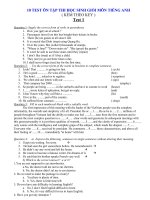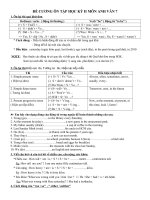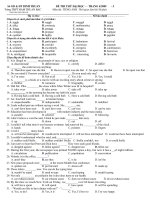Thi HTTDHTD Tieng Anh
Bạn đang xem bản rút gọn của tài liệu. Xem và tải ngay bản đầy đủ của tài liệu tại đây (607.7 KB, 33 trang )
<span class='text_page_counter'>(1)</span>CHUYÊN ĐỀ TIẾNG ANH THÌ HIỆN TẠI ĐƠN VÀ THÌ HIỆN TẠI TIẾP DIỄN Giáo viên: Mai Phương Thanh & Nguyễn Thùy Dương. Sao, 10/ 12/ 2015. Ngôi.
<span class='text_page_counter'>(2)</span> Warm-up: thêm s, hoặc es vào các động từ sau say. says. close. closes. brush. brushes. start. starts. finish. finishes. do. does.
<span class='text_page_counter'>(3)</span> CONTENT Present simple tense. B. Present continuous tense C. Practice. A..
<span class='text_page_counter'>(4)</span> A/. Present simple tense ( Thì hiện tại đơn) I/. FORM:.
<span class='text_page_counter'>(5)</span> Hi. My name is Nam. I am a student. And you?. Nam. Hello. My name is Lan. I am a student, too.. Lan.
<span class='text_page_counter'>(6)</span> 1/. Thì hiện tại đơn với động từ “ to be” ( is/ am/are) : -. Nghĩa: thì, là, ở, bị, được.. định: - a) ÁpKhẳng dụng: giới thiệu tên, tuổi, nghề nghiệp; tả người, vật,…. E.g:. I am a student. Nam is a student. Nam and Lan are students. I She/ He/ It/ Danh từ số ít We/ You/ They/ Danh từ số nhiều S. + am…… + is……… + are…….
<span class='text_page_counter'>(7)</span> b) Phủ định: E.g. I am not a student. Nam is not ( isn’t) a student. Nam and Lan are not ( aren’t) students. =>. S + to be not + ……...
<span class='text_page_counter'>(8)</span> c) Nghi vấn: E.g. Are you a student ? – Yes, I am / No I am not. Is Nam a student ? – Yes, he is/ No, he isn’t. Are Nam and Lan students?- Yes, they are/ No, they aren’t.. To be + S +……..? - Yes, S+ to be/ No, to be+ not..
<span class='text_page_counter'>(9)</span> d). Wh – question: Wh- words: what, what time, when, where, how, why, which,…. E.g: What is this/ that? How are you?. Wh- word + to be + S +…..?.
<span class='text_page_counter'>(10)</span> 2/. Thì hiện tại đơn với động từ thường: What time do you get up and go to school?. I get up at 6.00 and go to school at 7.15..
<span class='text_page_counter'>(11)</span> a). Khẳng định: E.g:. I get up at 6.00 and go to school at 7.15. Lan gets up at 6.00 and goes to school at 7.15.. I/ We/ You/ They/ Danh từ số nhiều + V …………... S1. She/ He/ It/ Danh từ số ít + V( s/es) +…………………. S2.
<span class='text_page_counter'>(12)</span> Chú ý: Cách thêm s, es vào sau động từ dùng với ngôi thứ 3 số ít -. Những động từ kết thúc là: o, s, sh, ch, x, z thì thêm es.. E.g. go -> goes, pass -> passes, wash -> washes, watch -> watches, mix -> mixes, buzz -> buzzes,….. - Những động từ kết thúc là y mà trước y là một phụ âm thì đổi y -> i, sau đó thêm es. E.g. try -> tries, copy -> copies,…. - Các trường hợp còn lại thì thêm s. E.g. live, stay, get, read,…...
<span class='text_page_counter'>(13)</span> b) Phủ định: E.g.. I don’t get up at 6.00. Lan doesn’t get up at 6.00.. S1 + don’t + V +……… S2+ doesn’t.
<span class='text_page_counter'>(14)</span> C) Nghi vấn: E.g: Do you get up at 6.00 ? – Yes, I do/ No, I don’t. Does Lan get up at 6.00 ? – Yes, she does/ No, she doesn’t. Do + S1 => Does + S2. - Yes, S1 + do/ No, S1+ don’t. +. V ….. ? - Yes, S2 + does/ No, S2 + doesn’t..
<span class='text_page_counter'>(15)</span> d). Wh- question: E.g. What time do you get up? How do you go to school? How does she go to school?. Wh- word + do/does + S+ V……..?.
<span class='text_page_counter'>(16)</span> II/. USAGES: - Chỉ hành động lặp đi lặp lại, thói quen ở hiện tại và thường dùng với các trạng từ: every, always, usually, often, sometimes, never: E.g. Every day, I go to school at 12.00. My father often drinks tea after meals.. - Diễn tả một chân lí, sự thật hiển nhiên: E.g. The sun rises in the East..
<span class='text_page_counter'>(17)</span> B/. Present continuous tense ( Thì hiện tại tiếp diễn).
<span class='text_page_counter'>(18)</span> I/. Form: 1). Khẳng định:. E.g:. I am learning English.. I am learning English now. Hoa is learning English now. They are learning English now.. S+ to be + V-ing +………... Hoa.
<span class='text_page_counter'>(19)</span> b). Phủ định: E.g. I am not learning English now. Hoa is not learning English now. They are not learning English now.. S + To be + not + V- ing +…… Chú ý: is not = isn’t are not = aren’t..
<span class='text_page_counter'>(20)</span> c). Nghi vấn: E.g. Are you learning Enghlish now? – Yes, I am/ No, I am not. Is she learning English now? – Yes, she is/ No, she isn’t. Are they – Yes, they are/ No, To learning be + S English + V-ingnow? +…..? they aren’t. -> Yes, S+ to be/ No, S + to be not..
<span class='text_page_counter'>(21)</span> d). Wh- question: E.g. What are you doing now? Where is she going?. Wh- word + to be + S + V-ing +….?.
<span class='text_page_counter'>(22)</span> II/. Usages: -Diễn tả hành động đang diễn ra ở hiên tại, hoặc xung quanh thời điểm nói và thường dùng với các trạng từ: now, at the moment, at present E.g. They are building a new school here now.. -Không dùng với các động từ chỉ nhận thức,. tri giác: see, hear, understand, know, like, love, hate, seem,…..
<span class='text_page_counter'>(23)</span> *) Một số lưu ý khi thêm –ing vào sau động từ: - Những động từ tận cùng là e -> bỏ e thêm -ing. E.g. take => taking, drive => driving,…. -. Những động từ tận cùng là ie -> đổi ie thành y sau đó thêm -ing. E.g. lie -> lying, die -> dying,….. -. Những động từ 1 âm tiết tận cùng là phụ âm, trước nó là một nguyên âm thì gấp đôi phụ âm rồi mới thêm – ing. E.g. put -> putting, win -> winning,…..
<span class='text_page_counter'>(24)</span> C/. PRACTICE:.
<span class='text_page_counter'>(25)</span> Exercise 1.. a. 1. It’s Thursday, and my father is teaching English. a. Present simple. b b. Present continuous.
<span class='text_page_counter'>(26)</span> 2. He doesn’t usually teaches on Monday.. a a.. Present simple. b. Present continuous.
<span class='text_page_counter'>(27)</span> 3. He is teaching a class for new students. a. Present simple. b b. Present continuous.
<span class='text_page_counter'>(28)</span> Exercise Choose the best answer or D)( 1-10) for each Choose the2.best answer (A,B,C, or D for (A,B,C, each sentence sentence . 1.Excuse me , ……………….you speak English? a . do a. b. does. c. are. d. is. 2. “ Where’s John?” - ” I ……………know.” a. am. b. b don’t. c. isn’t. d. are. 3. What’s so funny? – Why ……….you laughing? a . do. b. does. c c. are. d. don’t.
<span class='text_page_counter'>(29)</span> Choose the best answer (A,B,C, or D Exercise 2. for each sentence ( 1-10). 6. Am I your teacher? a . Yes, you a are b. Yes, you are not. c. Yes , you d . Yes , I am. 7.The swimming pools …………..at 9.00 am everyday. a . opens. b. b open. c. openes. b. opennes.
<span class='text_page_counter'>(30)</span> Choose the best answer (A,B,C, or D for each sentence ( 1-10). Exercis e 2 8. Where ………….. Susan a . do. b. is. come from? c. are. d. does d. 9. They ……….singers, they are doctors. a .are. b. is. c. a aren’t. d I’m not. 10. ………….. they work hard every day? a . Does. bb. Do. c . Don’t. d . Doesn’t.
<span class='text_page_counter'>(31)</span> Exercise 3. Write sentences from these words use present simple or present continuous. 1.. Tom / always / get up / early.. 2. What/ the children/ doing /? 3. Why /you/ looking /me ? 4. They / not listen / music/ after dinner. 5. Every morning/ he/ have/ big breakfast / and / go to school/ 7.00. 6. They/ watch TV/ at the moment. 7. Every afternoon/ Lan and Mai/ go/school/bike..
<span class='text_page_counter'>(32)</span> => Tom always gets up early.. => What are the children doing? => Why are you looking at me? => They don’t listen to music after dinner . Every morning, He has a big breakfast and he goes to school at 7.00 => They are watching TV at the moment. => Every afternoon, Lan and Mai go to school by bike ..
<span class='text_page_counter'>(33)</span>
<span class='text_page_counter'>(34)</span>









